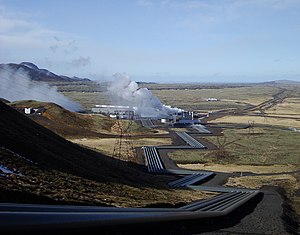Hellisheiði_Power_Station
Hellisheiði Power Station
Geothermal power station in Iceland
The Hellisheiði Power Station (Icelandic: Hellisheiðarvirkjun, Icelandic pronunciation: [ˈhɛtlɪsˌheiːðarˌvɪr̥cʏn]) is the eighth-largest geothermal power station in the world and largest in Iceland.[1] The facility is located in Hengill, southwest Iceland, 11 km (7 mi) from the Nesjavellir Geothermal Power Station. The plant has a capacity of 303 MW of electricity and 200 MWth of hot water[2] for Reykjavik's district heating.[3] The power station is owned and operated by ON Power, a subsidiary of Reykjavík Energy.
This article's factual accuracy may be compromised due to out-of-date information. (April 2013) |

